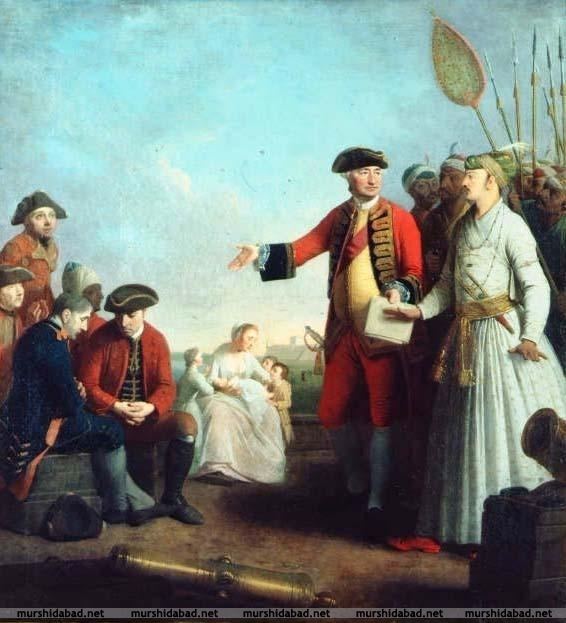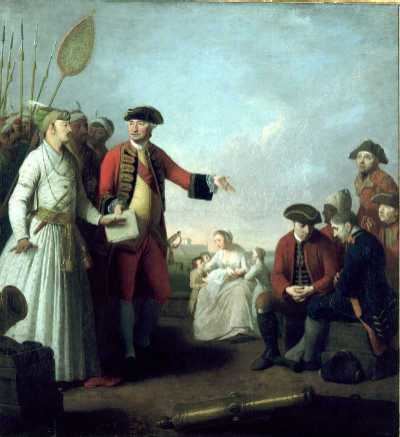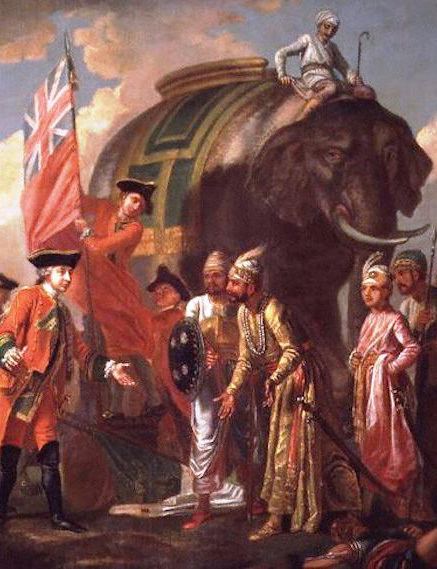Dynasty Najafi | Name Mir Jafar Grandchildren Babar Ali Khan | |
 | ||
Reign 1757–1760 and 1763-1765 Wives Shah Khanum Sahiba (m. 1727, d. August 1779)Munny Begum (m. 1746, d. January 10, 1813)Rahat-un-nisa Begum (Mut'ah wife)Babbu Begum (d. 1809) Issue Sadiq Ali Khan Bahadur (Mir Miran)Najimuddin Ali Khan BahadurNajabut Ali Khan Bahadur (Mir Phulwari)Ashraf Ali Khan BahadurMubaraq Ali Khan BahadurHadi Ali Khan BahadurFatima Begum SahibaMisri BegumRoshan-un-nisa Begum Sahiba (Nishani Begum)Husaini Begum and 2 more daughters. Father Sayyid Ahmed Najafi (Mirza Mirak) Children Najmuddin Ali Khan, Najabat Ali Khan, Ashraf Ali Khan Similar People | ||
Mir Jafar Ali Khan Bahadur (c. 1691–February 5, 1765) was the first Nawab of Bengal with support from British East India Company. He was the second son of Sayyid Ahmad Najafi. His rule is widely considered the start of British imperialism in India and was a key step in the eventual British domination of vast areas of the subcontinent. By the defeat of Siraj ud-Daulah in the Battle of Plassey, Mir Jafar became the Nawab in 1757 with military support from the British East India Company. However, Jafar failed to satisfy constant British demands for money. In 1758, Robert Clive discovered that through his agent Khoja Wajid, Jafar had made a treaty with the Dutch at Chinsurah. Dutch ships of war were also seen in the River Hooghly. Circumstances led to the Battle of Chinsurah. British company official Henry Vansittart proposed that since Jafar was unable to cope with the difficulties, Mir Qasim, Jafar's son-in-law, should act as Deputy Subahdar. In October 1760, the company forced him to abdicate in favor of Qasim. However, Qasim's independent spirit and plan to force the East India company out of his dominion led to his overthrow, and Jafar was restored as the Nawab in 1763 with the support of the company. Mir Qasim however refused to accept this and went to war against the company. Jafar ruled until his death on January 17, 1765 and lies buried at the Jafarganj Cemetery in Murshidabad, West Bengal, India.
Contents
- Who Was Mir Jafar ABP News
- Mir Jafar Biggest Traitor Of India
- Subedar of the Nawab of Bengal
- Nawab of Bengal
- Shah Alam IIs attempts to overthrow Mir Jafar
- Legacy
- References

Who Was Mir Jafar? | ABP News
मीर जाफ़र || की ‘गद्दारी’ की || अनसुनी कहानी || Mir Jafar || Biggest Traitor || Of India
Subedar of the Nawab of Bengal

In 1747 the Marathas led by Raghoji I Bhonsle, began to raid, pillage and annex the territories of the Alivardi Khan, the Nawab of Bengal. During the Maratha invasion of Odisha, its subedar Mir Jafar and Ataullah the faujdar of Rajmahal completely withdrew all forces until the arrival of Alivardi Khan and the Mughal Army at the Battle of Burdwan where Raghoji I Bhonsle and his Maratha forces were completely routed. The enraged Alivardi Khan then dismissed the shamed Mir Jafar.
Nawab of Bengal

Mir Jafar pretended loyalty to Alivardi Khan's successor Siraj Ud Daulah, but betrayed him to the British in the battle of Palashi. After Siraj Ud Daulah’s defeat and subsequent execution, Jafar achieved his long-pursued dream of gaining the throne, and was propped up by the British East India company as puppet Nawab. Jafar paid Rs. 17,700,000 as compensation for the attack on Calcutta to the company and traders of the city. In addition, he gave bribes to the officials of the company. Clive, for example received over two million rupees, Watts over one million Soon, however, he realized that company's expectations were boundless and tried to wriggle out from under them; this time with the help of the Dutch. However, the British defeated the Dutch at the Battle of Chinsurah in November 1759 and retaliated by forcing him to abdicate in favor of his son-in-law Mir Qasim. However, Qasim proved to be both able and independent, strongly condemned the interference of East India company in the governing of his domain. Mir Qasim formed an alliance to force East India company out of East India. The Company soon went to war with him and his allies. The Battle of Buxar was fought on 22 October 1764 between the forces under the command of the British East India Company led by Hector Munro and the combined army of Mir Qasim, the Nawab of Bengal: the Nawab of Awadh and the Mughal Emperor Shah Alam II. With the defeat in Buxar, Mir Qasim was eventually overthrown. Mir Jafar managed to regain the good graces of the British; he was again installed Nawab in 1763 and held the position until his death in 1765.
Shah Alam II's attempts to overthrow Mir Jafar

In the year 1760 after gaining control over Bihar, Odisha and some parts of the Bengal, the Mughal Crown Prince Ali Gauhar and his Mughal Army of 30,000 intended to overthrow Mir Jafar, Imad-ul-Mulk after they tried to capture or kill him by advancing towards Awadh and Patna in 1759. But the conflict soon involved the assertive British East India Company. The Mughals were led by Prince Ali Gauhar, who was accompanied by Muhammad Quli Khan, Hidayat Ali, Mir Afzal and Ghulam Husain Tabatabai. Their forces were reinforced by the forces of Shuja-ud-Daula and Najib-ud-Daula. The Mughals were also joined by Jean Law and 200 Frenchmen and waged a campaign against the British during the Seven Years' War.
Although the French were eventually defeated, the conflict between the British East India Company and the Mughal Empire would continue to linger and ended in a draw, which eventually culminated during the Battle of Buxar.
Legacy
The breakup of the centralized Mughal empire by 1750, led to creation of a large number of independent kingdoms (all provinces of the former Mughal empire). Each of them were in conflict with their neighbor. These kingdoms brought weapons from British-French East India company's to fuel their wars. Bengal was one such kingdom. British and French supported the princes whoever ensured their trading interest. Jafar was one such puppet who came to power with support of British East India company. After the defeat of Sirajuddoula and later Mir Qasim the British strengthened their position in Bengal and in 1793 abolished Nizamat (Mughal suzerainty) and took complete control of the former Mughal province. Jafar is widely reviled by the people of Bangladesh, India and Pakistan. The word "mirjafar" in Bengali and the phrase "meer jafar" in Urdu, are used much as quisling is used in English, and Jaichand of Kannauj in Indian history. Allama Iqbal, in his poetry wrote about his treachery in these words, "Jaffar az Bengal, Sadiq az Deccan; nang-e-deen, nang-e-millat, nang-e-watan" which mean "Jafar(Mir) of Bengal and Sadiq(Mir) of Deccan are a disgrace to the faith, a disgrace to Nation, a disgrace to Country. British with the help of Jafar and Mir Sadiq were able to take control of Bengal and kingdom of Mysore (Sultanat-e-Khuda daad)."
Jafar's great-grandson Iskandar Mirza, who had joined Army in 1920 in Military Police, was appointed and served as the first President of Pakistan.
